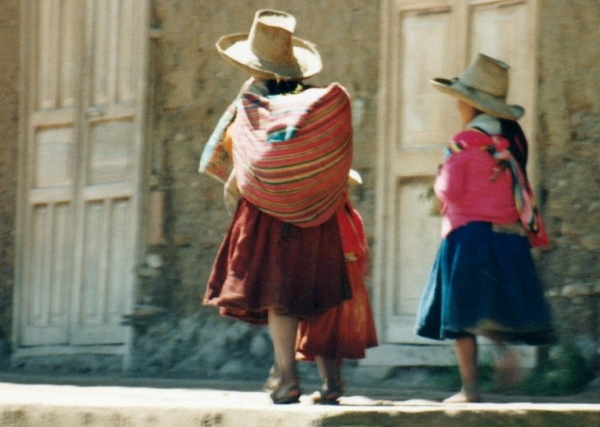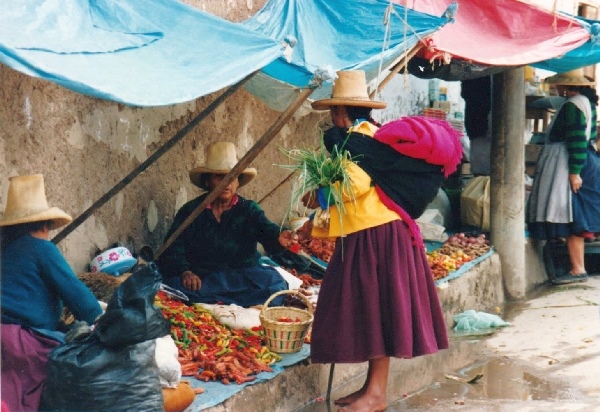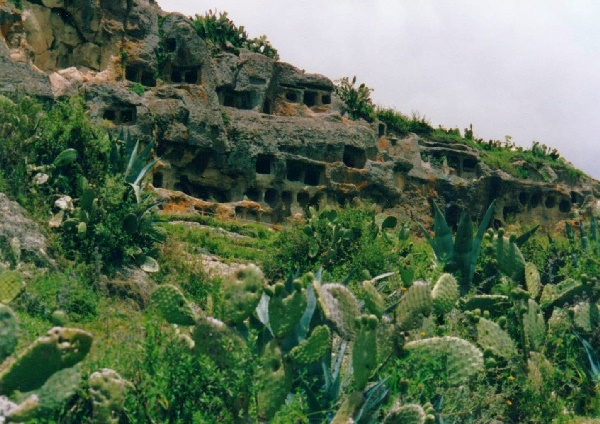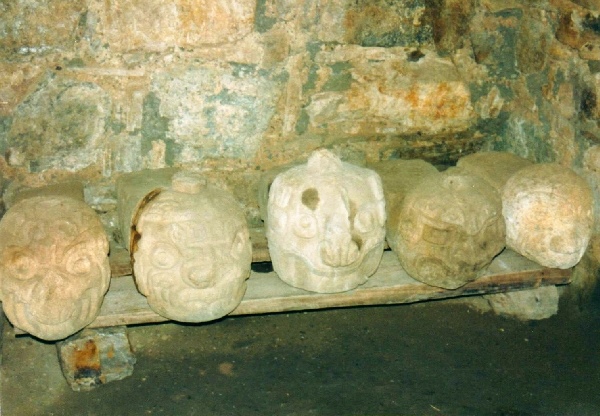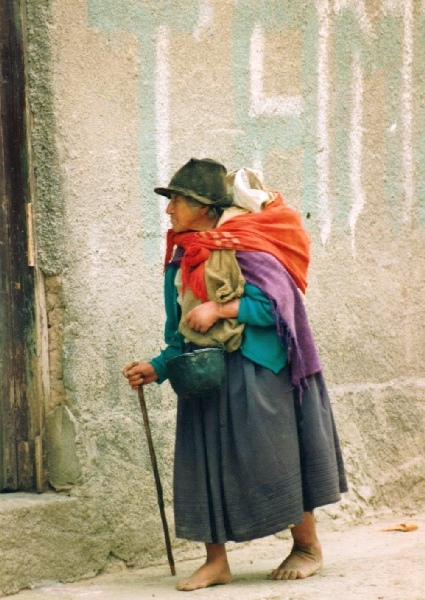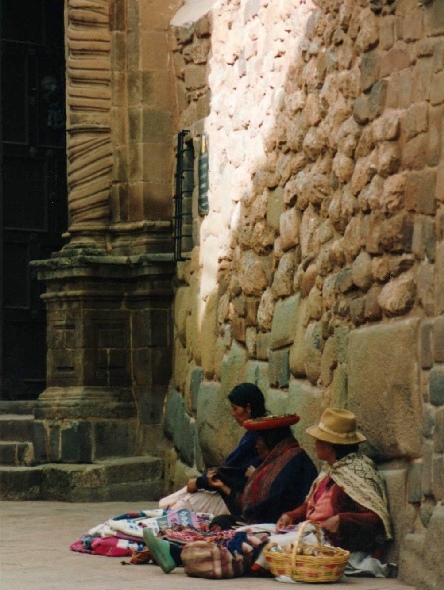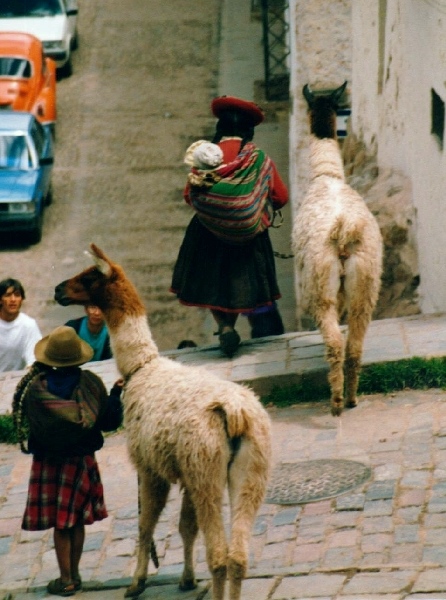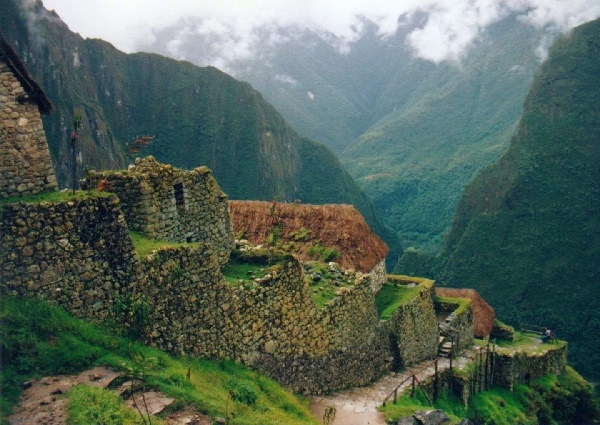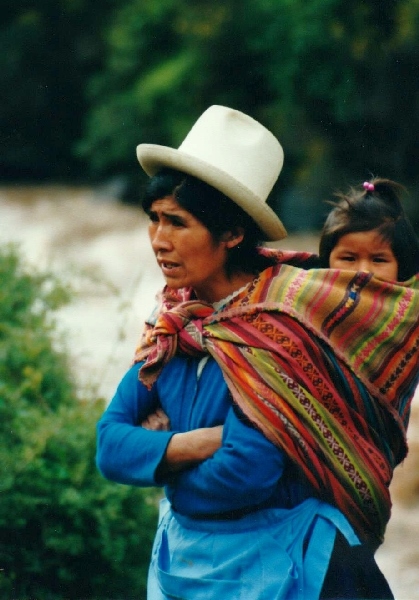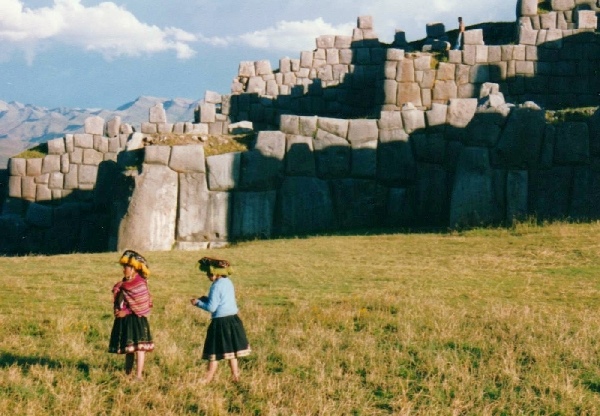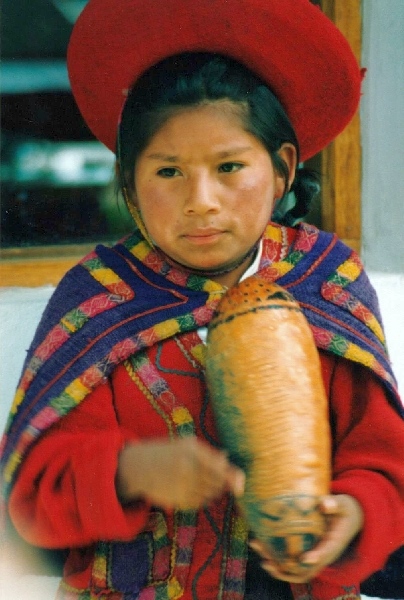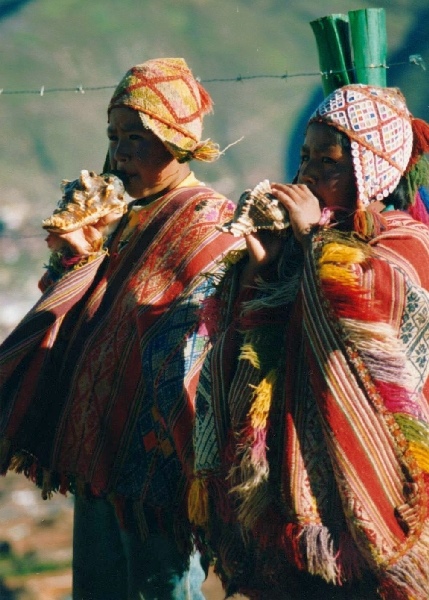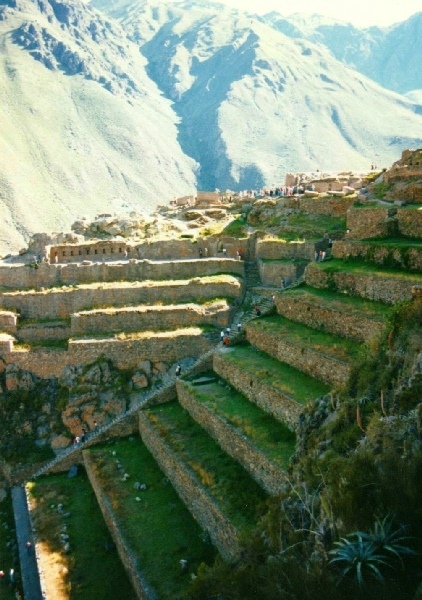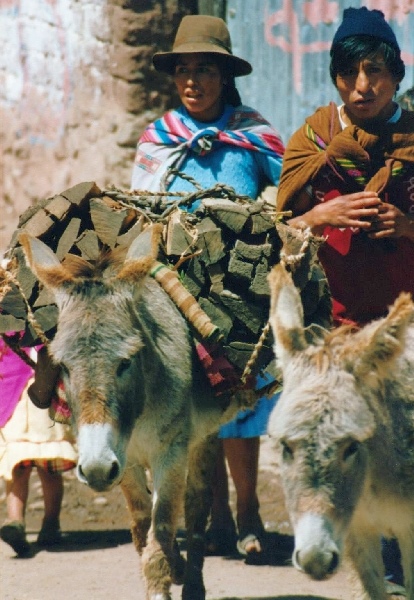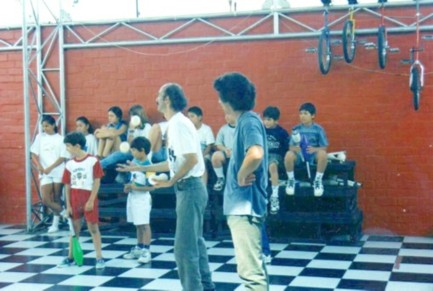World traveler Clown Tom Bolton
Adventure stories & photos

Tom’s travels in Peru, South America
Archeological & natural wonders of Peru
I made 2 trips to Peru, the first a continuation of a trip from Ecuador in early 1994, which went as far as Lima. The second trip was early ’96 and started from Lima and continued on through the southern part of the country. My impression coming from Ecuador is that Peru was livelier in both good and bad ways. More people begging and trying to short change one as a gringo. Yet many incidents of generosity and curiosity by people who hadn’t seen any tourists for a long time due to the Shining Path insurgency. Some of the people (often attractive women) who approached me might have been ones looking for a rich foreigner to either marry or do some dirty business with. Yet many seemed genuinely interested just to chat.
Seeing tourists arrive being like the first flowers signaling the coming of spring after a long, hard winter. I do remember once having a guy hassle me for money because “it was his land, his culture and his landscapes”. I replied that he was wearing jeans, drinking a coke and most likely watches TV and Hollywood films which all come from my culture – so maybe he should pay me! And as much as I regret how the Spanish conquered Latin America, the history of Peru is full of conquests, the Incas just being the last of the big native groups to beat up on some other culture before Europeans arrived. I first stopped in the cities of Sullana and Chiclayo on my way to Cajamarca.
Cajamarca
I stopped in Cajamarca which I found attractive but the people a bit aggresive towards tourists. The city was centered around a very large plaza with a fountain in the middle. On one side of the plaza was the large Church of San Fransisco. On the other side was the Cathederal also known as Mother Santa Catalina Church shown below. The Cathedral was smaller than the church across but looked to be older. The signature fashion for this area was the extremely tall white hats most women and some men wore.
Ventanillas de Otuzco
From Cajamarca I made a daytrip 8 kilometers to Vantanillas de Otuzco, which are burial niches carved into the hillsides as seen below. Different Indian groups in this part of northern Peru had ceremonially mummified people which were often place in niches or caves in often very inaccessible cliff sides. The dry climate has helped preserve these mummies some of which are said to be the oldest in the world. As the Incan empire conquered these regions they incorporated some of these religious burial methods.
Cumbe Mayo
I also went to the ruin of Cumbe Mayo, which is an ancient aqueduct system at 3000 meters, which redirected water from the Atlantic to the Pacific watershed. The irrigation it provided makes this project a significant landmark in the history of agricultural development. Unfortunately, none of these sites looked worth using my film on.
Chachapoyas
Continuing up into the highlands from Cajamarca, I reached the village of Celendin. Seems they rarely saw foreigners there and people kept mentioning the 2 bicyclists that had passed through 2 weeks, or maybe it was 2 months before. There was a road that would circle around up to Chachapoyas, a hundred miles or so away. But word was that there was just one bus a week and we had just missed it the day before or maybe not. I had hooked up with 2 young English guys and we got up at 4 am to try to get the bus that some people claimed would probably, maybe, perhaps come. And if not the bus then a truck would surely come – or so many people believed. But we waited all morning to no avail and went back to the hotel to sleep the afternoon away.
With hindsight, I think we would have found something if we had stuck it out for the rest of the day or the next day but we were impatient. So we did the only sure thing. We went back down to Cajamarca, down to Chiclayo on the coast and swung north and from there up to Chachapoyas. A diversion of around 800 kilometers down and up the Andes! I mostly grabbed some small provisions from kiosks in the bus stations on this journey so I didn’t eat properly for a couple of days. Remember passing on the opportunity to buy a loaf of “Molde” brand bread, which didn’t sound so appealing despite my lack of food.
Keulap archeological site
This was an extensive ruin called Kuelap near the city of Chachapoyas in northern Peru. It is not as spectacular but is bigger and higher than Machu Picchu and is supposed to have been built by a culture that predates the Inca Empire. It is very remote, not that the terrain was so rugged but there simply weren’t any good roads connecting the area to the coast. It was beautiful but was quite an adventure to get there. Had to take a bus to the village of Tingo and walk many kilometers. Along the way we had to cross the river on a platform hung on a cable. There were a lot of interesting scenes along the road there. Farmers in their fields, herding their animals on the road, a child who came to try to sell us some herbs. There were also a lot of huge cactus plants that grew along the sides of the roads. I had to wonder if they grew there naturally or if someone had gone to a great effort to beautify a country road.
Yalape
The area around Chachapoyas was full of ruins in addition to Kuelap. I made a day trip to Yalape near Levanto, which was recommended by the South American Handbook. Had to take a taxi to get there and although it covered an extensive area, it was overgrown with brush and thorns. They had cut down many large trees in recent years to “clear” the ruin but this just gave the opportunity for the fast-growing small brush to take over so that one needed a machete to explore. I think the S.A. Handbook was perhaps a little off on this tip but otherwise was a great source of information that surpassed the Lonely Planet guides in both detail and breadth of coverage by a long shot.
Trujillo, Huanchaco & Chan Chan, capital of Chimor culture
After having seen the Cajamarca and Chachapoyas regions I went down towards the coast and south to the northern city of Trujillo, third largest in Peru. The center of Trujillo was impressive but I seem to have just one photo from there; of the Cathedral including a small section of the fountain in the center of the main plaza. Didn’t take many photos because I stayed at a beach town close by called Huanchaco. It was nothing great but relatively relaxed and I ate a lot of good seafood. Stayed away from the ceviche, a popular raw fish dish. There were signs warning of cholera in the area and no better way to get it than eating uncooked food. We some cool reed boats in the water but I didn’t risk taking my camera to the beach with me. Both theft and sand were deterrents.
Near Trujillo are extensive ruins of a city called Chan Chan, which is claimed to have been the largest pre-Columbian city in South America. It was the capital of the Chimor culture until the Incas conquered it in the 15th century. Most of this coast is desert but the Moche River, one of the few starting in the Andes that run to the pacific, leaves this area fertile. The city was built of adobe walls, which were often decorated by inscriptions of animals.
One can still make out figures but I suspect many of them have been extensively “redone”. The remains are threatened by looters and excessive weather caused by el Niño. Despite what one might expect, there are few, if any, nice beaches on most of the northern Peruvian coast with the exception of the fishing village of Huanchaco. The water is cold for swimming and most of the towns seem to live from their fish canneries which always had a fishy, metallic stink that burned your sinuses from dozens of miles away.
Casma, Huarez coca leaves in stores
Going south from Trujillo, I stopped in the small town of Casma intending to go to the ruins of Sechin. There was no transportation anymore and rather than spend an extra day, I continued up into the highlands once again, this time to the run down looking village of Huaraz. The English guys I had been traveling with stayed to see Sechin, which they said, was disappointing because it was mostly roped off for restoration work.
Huaraz was not an especially beautiful area except for the good views of a chain of snow-capped high peaks. On the trip I noticed bags of coca leaves for sale at the small shops by the bus stations. To think what a stink they make about such drugs in the west and there one could choose a 1-kilo, 2-kilo or the family-sized 50-kilo bag! This area is prone to earthquakes and in one restaurant they had signs everywhere of which way to run in case of a quake. Looked like it was split into smoking, non-smoking and earthquake sections.
Chavin de Huántar, archeological site
From Huaraz I did a day-trip to the archeological site at Chavin de Huántar. It’s a pre-Inca ruin whose occupation dates back to 3000 BC and is a UNESCO World Heritage Site. The highpoint is the temple, shown here, which takes about 2 hours to be guided through. It is built mostly underground with dark, narrow passages and adorned with many intricate stone carvings. It was built with a drainage system due to the heavy rains but I felt a bit claustrophobic thinking what might happen if a tremor hit. Both inside and out were many carved stone heads. There were also elaborate etchings showing such crazy figures like this one with snakes coming out of his head like hair.
Chavin village
I strolled around Chavin with the 2 English guys I had been traveling with taking photos. It was not a very large village but it had a nice plaza in the center where I made a show. In return the children sang 2 songs for me. I think this is the only photo I have of me performing in Peru since I rarely had a trusted person to give my camera to. My companions were unfortunately not so good with photography so the shot is rather blurry and they didn’t think to zoom in. We were there for just 1 day and the next day caught an early bus to the capital Lima. Logically I would mention Lima next but I will skip it for now because I went from there up to Cusco and Machu Picchu and then returned to Lima. As I ended my stay in Peru in Lima, I put it at the end.
Peruvian highland city scenes
This following section contains images taken in a city in the northern Peruvian highlands. I just don’t remember now which city it was. Maybe someone can identify it for me?! Like most cities there was at least one crumbling church and other rather majestic buildings on a main plaza. Also, lots of markets and street vendors. Just from the local style of hat I know it was not Cajamarca where they also like white but taller hats – but in that part of the country. Anyway, the lifestyle was fairly representative for Peruvian communities.
Livestock in Peru, finding vegetarian food
Not just bananas or ice cream but plenty of cattle, bulls, lamas, sheep, hares and guinea pigs were offered in the markets. Guinea pigs are considered a delicacy in Peru and Ecuador. One saw them roasted on a spit in the markets although they could have been rats for all I knew. It wasn’t easy to find vegetarian food in Peru but sights like that were an inspiration. Many times I ordered something vegetarian only to find meat in it anyway. Thankfully, there were restaurants run by the Hari Krishna in most bigger cities, which were always wholesome, and strictly vegan.
Cusco capital of the Incas
From Chavin I went to Lima where I got a cheap flight to Cusco aka Cuzco. Cusco was the capital of the Inca Empire when the Spanish arrived. After conquering the city, the Spanish built many beautiful colonial buildings, often on top of Incan foundations. It’s a nice town to stroll around and I never had trouble but met many people who had been robbed here (Lima is even worse) and locals sometimes warned me that certain areas are risky. Around the central plaza was a lot of nightlife and although my hotel was just 6 blocks away it was worth a dollar to take a taxi at night be to be safe. There is a lot of poverty in the highlands and thieves know there will always be a stream of tourists here. Best not to wear any jewelry, just a cheap watch and above all, be aware of your surroundings.
Thieves are like any predators; they look for the easy victims. In any third world country one can find large strong sacks used to sell rice in the markets. Melt some holes for the shoulder straps and make a cover for your backpack. It is good protection against dust but mainly it makes it look incognito. Sometimes you travel on a bus and have to put your pack somewhere you can’t watch it every second. A nice backpack is a target, what looks like a sack of rice isn’t. A daypack should stay with you, if you put a backpack in an overhead rack, fasten it to the rack with the belt strap or else it can be quickly grabbed and thrown out a window to a thief’s accomplice. Some travelers add a layer of chicken wire to guard against bag slashers but this can make it awkward to access your pack yourself and I never found it necessary.
Plaza de Armas, Cusco Cathedral & churches
The central plaza is called La Plaza de Armas or Plaza Mayor. The 2 most notable landmarks surrounding Plaza Mayor are the Cusco Cathedral and the Society of Jesus (Jesuits) Church. The Cathedral is a UNESCO World Heritage site yet the Society of Jesus Church perpendicular across the plaza rivals it for majesticness. Supposedly the pope had to intervene to settle which one would be allowed to be bigger. Close by is the Mercedes Church and Monastery.
Cusco Cathedral stairs as theater space
This is close-up of the Cuzco Cathedral on Plaza de Armas. The stairs were a popular place for both tourists and locals to hangout in the late afternoons to watch the people go by. I made a couple of short shows here, which was great because it was like a filled theater and yes, the crowd pictured below was here of my audiences. Unfortunately, I didn’t have someone to take photos of me while performing. The Peruvian military also made a show of sorts by the Society of Jesus Church. I think I got a bigger audience and more laughs.
Cusco residents
Of course I took photos of people throughout the city. Most are Indians. Many seem to have come from the surrounding rural areas to sell things on the streets and markets. There were also many porters who carried goods to the markets on their backs attached by ropes. I even had a local warn me that one market area was a known place to get pickpocketed or robbed. Nice that they would see a tourist as a person to be cautioned rather than let them become a potential victim.
Machu Picchu, Peru attraction extraordinaire
One of the big attractions in Peru is of course the many ruins left by the Incas and other ancient cultures. Truly deserving its reputation as a manmade wonder, Machu Picchu, has the advantage of being set in a natural wonder of steep, cloudy peaks. The construction is of such precisely cut large stones that conspiracy theorists are more ready to believe it was made by aliens than ancient Indians. I’m including some similar view but being one of the world’s most spectacular views justifies it. The lamas fit so symbolically to this place yet this is one of the selfies every travel needs to make. There are often clouds at these high peaks but the sun broke through just as I arrived.
Bus connects train to ruins
To get there, one takes the train from the old city of Cusco. So many thieves and bag snatchers worked this train, watching their attempts were entertainment in its own right. A Peruvian woman I had met was in another carriage and a guy jumped in and tried to grab her purse. She reactively threw her cup of hot coffee in his face. The train stops by a river where there are many vendors pictured here trying to sell people provisions and souvenirs before they depart again.
From the train stop, a bus takes you up a long zig-zagging road. Its breath taking but such a hard to reach place, you wonder how it was found again none-the-less ever built. It was humorous on the bus ride down from the ruins. Some boys ran straight down a steep path which shortcut through all the winds of the road. They yelled greetings to us in the bus again and again as we would drive by and make the next hairpin turn. They deservingly got a tip from most of us when we disembarked below.
Trekking the Inca trail
Some hardy tourists trek a section of the old Inca trail in or out of Machu Picchu. When I asked one such adventurer what I missed, he said it was ten days of cold torrential rain and mud. Sorry I was on too tight of a schedule to enjoy that. It’s speculated that this was a religious center but who really knows. Just the scale of the rugged mountains and jungle made me wonder how a small bunch of Spaniards could cross an ocean and conquer an entire empire. Yeah, they had steel swords, armor and horses but the Incas were experienced warriors as well. The expression “live by the sword, die by the sword” comes to mind.
Sacsayhuaman Inca Fortress
Close to Cusco is the ancient Inca fortress of Sacsayhuaman, extensions of which continued to be discovered and unearthed in the time I visited. Not just the scale of the ruin is impressive but also the massiveness of the nearly house-sized stones. Although irregularly shaped, they fit together with absolute perfection like a huge puzzle. Built for the defense of Cusco, it played an important part during the battles with the Spanish, who managed to capture it and then use its position to hold out against the much larger Incan force.
I went to visit it with a Peruvian woman who had immigrated to England. She felt so annoyed that they demanded the tourist price from her rather than the local price that she insisted that we sneak in instead. We did manage but only after being comically followed around for an hour or so by some locals. We ever so nonchalantly walked around, often circling back and forth, looking over the barbed wire fences with the guards just waiting to catch us trying to gain entrance. One caught up with us as we were leaving and demanded money but we just jumped in a taxi and took off. My suggestion is to just pay the fee and have your peace. One usually has to buy a combination ticket for multiple sites around Cusco, so one ends up paying one way or the other anyway.
These women in their traditional dress were grazing their lamas at Sacsayhuaman but I think it was no coincidence that they chose such a tourist visited spot as they could always beg a few donations for having their picture taken.
Weaving and posing in traditional costumes
A few kids were tentatively also playing music by the Sacsayhuaman site. They were more or less posing for pictures for donations but such costumes and scenes are still common sights during any festival. Year later Europe and America are full of “living statues” that mostly have lousy costumes and do nothing so these guys were far better. And at least for the kids it wasn’t like hard labor or having to pester people to peddle things on the street. There was also a woman weaving traditional textiles – coincidentally right at a spot where she would get attention from the many visitors to the site.
Sacred Valley tour – Valle Sacrado – Ollantaytambo
Another day I made a day-trip from Cuzco touring the Valle Sacrado or Sacred Valley. The most significant thing we saw was the site of Ollantaytambo. This was a large fortress surrounded by terraces once used for agriculture. It is not quite as impressive as Machu Picchu but impressive none the less.
Sacred Valley – Pisac
Another stop on the Valle Sacrado tour was in Pisac. I don’t remember the ruins there but it was market day. There were lots of stands selling souvenirs, particularly textiles, near the old church but most of the market had other goods as well. Interesting for tourists but most of the people were locals of course.
Pisac – risk factor – ice cream
More so than anywhere I saw in Peru, ice cream seemed popular in Pisac market. I avoided eating ice cream in warm countries like Peru if the refrigeration might be in question since the risk of bacterial contamination is very high. I have rarely had stomach problems on my travels but did eat a couple of bad meals and once came down with giardia in Peru.
Sacred Valley – Chinchero
The last stop on the Valle Sacrado tour was in Chinchero. This was a small village that was also holding a market. Again, lots of local textiles for sale. The other attraction was the old church which looked all the more mysterious in the twilight as the sun was going down.
Lima capital of Peru
I both ended my first trip to Peru and started the second one in Lima. It’s a very hectic city of over 8 million residents where one has to take a lot of care. The center of the old city would normally be one of the worst areas but was also the most patrolled by police. On my first trip, I once returned at around 4 am from a night out and walked through much of the center. The biggest risk was not from thieves but from the jittery police who were heavily armed and positioned on virtually every corner. The Shinning Path insurgency had just recently ended (with an occasional hold out) and the security measures were still to be seen. One of capital’s big attractions was the gold museum, which was protected like it was Fort Knox. Things were much calmer in the swanky suburbs of Miraflores and Barranco but even by the beach there I saw thieves snatching things out of the windows of cars when they stopped for a light. Unfortunately, I seem to have misplaced the rest of my photos of Lima. I took a few but due to security reasons rarely showed my camera.
La Tarumba circus school
I was in a trendy bar in the upscale Lima suburb of Barranco when I met Michelle. She saw me checking out the photo exhibition on the wall and asked me if I wasn’t also a photographer or an artist like herself. I replied that I took photos but was a juggler and professional clown. To my surprise, she said that her Argentinean boyfriend was also a juggler and did I know of the local circus school and theater group? The next day we met and she took me to “La Tarumba” They teach circus skills and music to kids and bring messages of hope and fairness to an impoverished country, which was emerging from years of civil unrest.
They inspired me that a clown can actually impact society as a whole. I could show the kids some new juggling tricks and once I got back to Europe managed to write a story about them for the juggling magazine Kaskade (now defunct) and get some props donated for them. I found that a few people were very generous yet many manufacturers of juggling equipment were too stingy to give anything. The people of La Tarumba repaid this generosity many times over by picking me up at the airport and putting me up on my second visit to Peru. And when I made a later trip to Argentina, they lined me up with a place to stay with an instructor for the local circus school there as well.
La Tarumba was helped by an old actress who gave them a villa, which became home to their school. The courtyard has a circus tent like covering to protect them from the harsh sun. They have strung up trapezes and high wires so they really have a lot of the needed training equipment. The place is rather ideal except that the backside borders the busiest highways through the city. There are walls and fences that separate the highway so traffic is no danger to the kids but the noise is rather relentless and the air quality through Lima is terrible. What they most hoped for was technical advice like how to make proper safety riggings.
Cirque du Soleil – no help
I tried to contact Cirque du Monde, a part of Cirque du Soleil that is supposed to be helping such third world circus projects. I don’t know what they really do but they didn’t respond to my requests. More recently, I contacted them about a circus school in Nicaragua and waited about 9 months to get a bullshit excuse that they can’t help everybody. Cirque du Soleil has created some interesting things but their hyped-up contributions to the third world seem questionable. Looks to me like they are more interested in maintaining a supply of trained cheap, labor from the third world with motives of more profits rather than altruism. Luckily, La Tarumba seems to have prospered anyway having even fulfilled their dream of getting a circus tent for a permeant show space.

Second trip to Peru
I made a second trip to Peru in 1996, starting in Lima and going south on to Bolvia, Chile and Argentina.
See my page Peru-2
So, those were just a few tales from my many travels over the last thirty and something years. I hope you've enjoyed another side of a traveling clown! If you want, write me an email or better yet, book my show or set a link to this website or just state me as the beneficiary of your will!
To book or see more information about Tom's clown show and entertainment, visit one or both of his clown websites:
Clown Stuttgart www.clowntombolton.com
Clown juggler Stuttgart, Gremany www.clown-event.de


